For its proponents, algae hold the promise of a clean source of fuel, food or drugs. Anthony King wades in
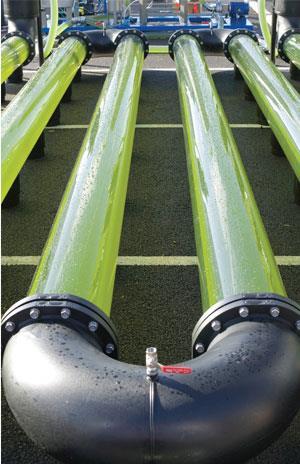
Pond scum – algae – gained prominence a few years ago, emerging from research obscurity to hog the green limelight. With questions over growing food crops for biodiesel and concerns over fuel security and global warming, algae seemed to offer a renewable, carbon-neutral source of fuel. Algal cultivation could use a large amount of non-arable land without harming food production, said the sales pitch, and its demand for water could be met with non-potable supplies, even saline or wastewater.
As algal biochemist Alison Smith of the University of Cambridge, UK, explains, ‘I was being phoned up every five minutes by people who wanted to talk about algae.’ That was in 2007, when she had helped found the UK’s Algal Biotechnology Consortium.
Six years on and algae are today used to produce feed for agri- and aquaculture and dyes like carotenoids. The latter are used industrially as food pigments and feed additives, and in cosmetics and pharmaceuticals, and there has been increasing interest in their potential as functional food ingredients. Algal biomass is the main source of polyunsaturated fatty acids, for instance, which are recognised as offering health benefits.
The algae eaten as food supplements are Spirulina, Dunaliella and Chlorella, generally as tablet or powder form. Spirulina thrives in water with such a high pH that it excludes potential competitors, which helps make production viable. The food supplement itself, in powdered form, smells like aromatic moss peat, earthy and floral. Earthrise Nutritionals, based in southern California in the US, produces about 500 tons annually of Spirulina in 30 one-acre ponds about a foot deep. The smoothie made from the powder tastes surprisingly good – fruity with an aromatic twist.
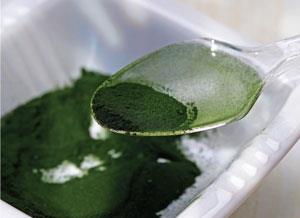
Apart from the reputed benefits of drinking the green stuff, some supporters of algae see them as a solution to feeding the world. Algae flour, proponents argue, can substitute for that made with corn, wheat, rice or soy, and algae oils offer a healthier alternative as they are higher in micronutrients and deliver more omega-3 fatty acids than many conventional oils.
Although algae’s potential to produce liquid fuel opened the door to funding back in 2007, it has not made inroads on large-scale commercialisation. ‘There are huge challenges in scaling up algae for industrial biotechnology purposes. We started with a focus on biofuels, but it became clear this was not something that would happen immediately. There needed to be a stepping stone,’ says Smith. What’s more, she says, the way forward must produce a revenue stream if private industry is to remain on board.
‘The biggest demand for algae at the moment is going to come from the food industry and neutraceuticals have great potential here,’ says Maeve Edwards, algal expert at the National University of Ireland, Galway. ‘In order to make biofuels work, we need to produce high value products from biomass along with fuel.’ Oil is a commodity dug out of the ground with an infrastructure built over decades; it is a tough competitor for any new fuel technology.
That cold, hard commercial reality now means Smith, like most algal experts, predicts that low volume, high value products will lead the charge. She is working on a new EU funded research project that aims to produce sustainable polymers from algae, such as polyesters and polyolefins, and on algae as a platform to produce various vitamins.
Sophisticated algae
‘There is the expression “familiarity breeds contempt” and algae have suffered from that,’ says Steve Mayfield, director of the University of California, San Diego’s Center for Algae Biotechnology in the US. ‘People dismiss them because they are that ubiquitous little organism that you clean from your birdbath or pool.’ They are very efficient at photosynthesis and are great little survivors, he says. ‘Those are enormous advantages when it comes to producing things.’ Mayfield sees algae contributing to cancer drugs, malaria vaccines and greener jet fuels.
You couldn’t have made that vaccine in bacteria, yeast, CHO cells or insect cells
Steve Mayfield
Earlier this year, Mayfield’s lab showed that the green algae Chlamydomonas reinhardtii can produce vaccine candidates for malaria. The development of the vaccine candidate Pfs48/45 had been limited because expression platforms either lacked the ability to fold the complex protein or cost too much. The proteins have a high degree of folding and lots of disulfide bonds so the bacteria most used in biotechnology, Escherichia coli, cannot make such proteins. Chinese hamster ovary (CHO) cells, another common biotech tool, make malarial proteins but they glycosylate them, impeding the immune response.
Not so the algae. ‘We made the malaria vaccine candidate inside the chloroplast. They work beautifully. When we injected them into mice, the mice had a very good immune response. You couldn’t have made that vaccine in bacteria, yeast, CHO cells or insect cells,’ Mayfield says.
Mayfield also led research that genetically engineered algae to produce a commercially relevant industrial enzyme, xylanase – critical if you like your jeans stonewashed. ‘This is an enzyme which clips the cellulose in jeans and makes them a little bit softer,’ Mayfield explains. ‘That is, believe it or not, a $250 million [~£160 million] product. If we can make it cheap enough and on a large scale, that would be a good example of an industrial enzyme from algae.’ And last year Mayfield led a study that produced five industrial enzymes in a marine alga. Of these five, mannanase and a-galactosidase could offer a greener enzyme for the pulp and paper industry and potentially be used in ethanol production from plants.
Affordable blockbusters
Mayfield notes that the newest anti-cancer drug in the US – Adcetris – will cost $160,000 per treatment. ‘Are you kidding? The NIH spends $30 billion a year and 99% of that goes into making the fanciest medicines possible. The rest of the world doesn’t even consider making medicines the way we do it in the States,’ he says. The new drug is fantastic and very effective, Mayfield argues, but we need to look at new ways of producing more affordable medicines and algae may come up trumps.
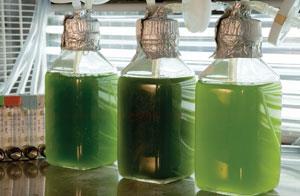
This is not just California dreaming: in December 2012, Mayfield reported that he had fused a toxin with an antibody to target a B-cell surface protein. The cancer drug candidate, produced inside green algae, bound to B cell lymphomas and killed them. ‘We also implanted human tumours in mice and showed that we could actually cure the mice of that human tumour,’ Mayfield says.
Ordinarily you make an antibody in CHO cells and chemically synthesise the toxin or make it in E. coli. Then you chemically link the two. CHO cells and yeasts are fussy, expensive systems to use. What algae offer is scalability and low cost. ‘That means we can do it cheaper,’ says Mayfield. ‘Many, many pharmaceutical companies have called me over the last few months after they read our paper on antibiotic–toxin fusion proteins.’
Greener fuel
Algae accumulate oils as nonpolar storage lipids, such as triacylglycerides, and these can be converted to biodiesel through transesterification, and to petrol or jet fuel though distillation and cracking. But they also hold potential for bioethanol production because of their low proportions of lignin and hemicellulose compared to land plants. And a study of five algal species showed that all produced more methane than maize silage in a fermentative biogas production test.
Some green algae even use captured solar energy to split water to produce molecular oxygen, as well as hydrogen ions and electrons that can be combined to produce hydrogen. It has been argued that a viable solar-powered hydrogen production system is a feasible prospect.
However, many see the clearest opening for photosynthesising algae – algae fixing their carbon from available carbon dioxide – in producing environmentally friendly aviation fuel, a high-value commodity that is difficult to make. The global airline industry consumes more than five million barrels of oil per day and algal blends offer advantages. Algal fuel is non-toxic and contains reduced levels of particulates, carbon monoxide, soot, hydrocarbons and SOx. It is also suitable for use in the aviation industry due to its low freezing points and high energy density, largely because it contains branched and aromatic hydrocarbons.
Production
Geneticists are working with just a handful of algal types, yet as a group they are stunningly diverse. ‘Somewhere between 60,000 and 80,000 species of algae have been identified, but the true number is much higher,’ says phycologist Milton Sommerfeld of Arizona State University in the US, who first got involved in looking for productive algal strains in the 1980s. ‘We continue to look for better strains because we believe the best one hasn’t been found yet.’
There are millions out there and that diversity poses problems for geneticists, who find that engineering tools for one algal type just will not work with others. But arguably the stiffest challenge for algae production systems is cost reduction, and finding newer algae could help solve the problem. Sommerfeld says the most productive strain they found came from a temporary pond in urban Phoenix after heavy rains.
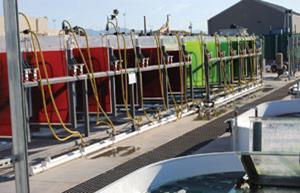
As for growing systems, algae can be produced agriculturally in vast pond complexes, or grown industrially in photobioreactors (PBRs). Most experts favour PBRs because they allow for more controlled environmental conditions, suitable for higher value products. ‘The trouble with an open pond is that a duck can land on it, rats can swim in it and they can get contaminated with other organisms,’ says algal expert Bob Lovitt of Swansea University in the UK. He is involved in a European consortium called EnAlgae, which aims to reduce dependence on fossil fuel in northwest Europe by developing algal biofuels.
A 2011 lifecycle analysis found that PBRs illuminated by light-emitting diodes (LEDs) produced significantly more biomass (~250 tonnes per hectare) than solar PBRs (~8t/ha) and open ponds (~5t/ha). But the pond system cost $3 per kilogram, five times lower than the solar-lit reactor system and eight times lower than the LED system.
Smith has noted that a major challenge of growing algae commercially at scale is the difficulty in maintaining the optimal conditions for growth and lipid synthesis achieved in the lab. There are also basic agricultural issues to address, such as controlling competitors, pests and diseases, and the need to improve yields. Smith also argues that it is better to grow a variety of microbial species, rather than just a single algal strain.

Sommerfeld’s Arizona Center for Algae Technology and Innovation (AzCATI) is a test and evaluation facility for other researchers wishing to try out new processes and strains. Visitors to his office can even try algal cookies, made from a secret recipe that Sommerfeld keeps closely guarded. The four-acre facility across from his office hosts a variety of ponds, panel reactors and tubular reactors and there is no shortage of interest. Indeed, the US has seen a great deal of activity among algal start-ups.
Solazyme, headquartered in San Francisco with operations in Illinois and Brazil, uses algal fermentation to convert biomass directly into oil and ingredients for consumer products including food and anti-wrinkle cream. Florida-based Algenol is focusing on using algae to produce and secrete ethanol, while Sapphire Energy of San Diego aims to create ‘green crude’ for conventional refining. In a high profile move, ExxonMobil started a $600?million research programme in collaboration with Craig Venter’s San Diego-based Synthetic Genomics aimed at creating superior algal strains and more efficient production processes though genetic modification.
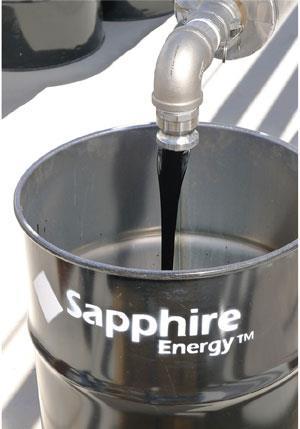
Lovitt sees the ultimate goal as the algal biorefinery, producing valuable products such as omega-3 fatty acids, speciality fuels, and neutraceuticals. ‘The idea is to make high value products from 10% of the biomass and use the rest of it in energy production,’ he explains. This vision of the leftovers producing energy has gained traction, but so have efforts to combine algal production with municipal wastewater and carbon dioxide. ‘This will be about finding cheap sources of carbon dioxide and about nutrients coming out of sewage plants and off agricultural land,’ Lovitt explains, although success is some way off.
‘We are 10 years away from a full-scale demonstrable production of fuels using algae. We have to overcome problems culturing them. Harvesting is also a significant problem because algae are grown at relatively low concentrations, which adds to cost,’ Lovitt says.
Lovitt foresees a day when algal reactors could be ubiquitous in urban architecture, greening our cities: ‘Algae biorefinery technology sits very well with city life, where you can use all the surfaces you’ve got in a city.’
Therapeutic algae
Visions of algae growth chambers lining a metropolis will not take form within the next decade, but algae may churn out valuable products well before then. Mayfield predicts that next year his work will contribute to the market launch of a valuable therapeutic protein for babies.
Previous studies identified a protein called MAA in colostrum, the healthful milk new mothers produce in the first 24 hours after birth. Mayfield engineered algae to produce high levels of this protein and fed it to pigs. The protein stimulates mucous production on the gut lining, building a physical barrier against bacteria and viruses. ‘The pigs fed on it were much more resistant to bacterial infection,’ says Mayfield. ‘But the Gates Foundation didn’t give us that money so we could keep pigs from getting bacterial infection. They gave it to us because pigs are a good model for humans, and bacterial diarrhoea is the number one killer of children.’
The algae can be dried, stored at room temperature and mixed with baby formula. The fact that the therapeutic protein can be simply eaten as algal matter means the price is reduced by a factor of a thousand, Mayfield says. Of course pigs and other animals could also benefit.
Mayfield says big pharma is conservative and will take time to come around to algae production systems. ‘It is really the start-up companies that are going to drive this technology,’ he predicts. Already, the high value products from algae are worth around $8 billion a year, he says, but higher value products are on the way. ‘We can tweak the metabolism of algae,’ he says ‘and they require ultracheap inputs to produce any product you want.’
Anthony King is a science writer based in Dublin, Ireland
Further reading
• The UK Algal Biotechnology Consortium: www.bioenergy.cam.ac.uk
• Mayfield’s work on malaria vaccine candidates: C S Jones et al, Appl. Micobiol. Biotechnol., 2013, 97, 1987 (DOI: 10.1007/s00253-012-4071-7)
• Mayfield’s work on cancer therapeutics: M Tran et al., Proc. Natl. Acad. Sci. USA, 2012, DOI: 10.1073/pnas.1214638110
• The EU EnAlgae project: www.enalgae.eu
• Arizona Center for Algae Technology and Innovation: www.azcati.com





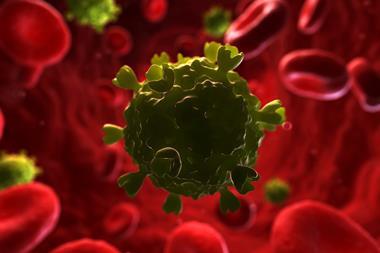






No comments yet